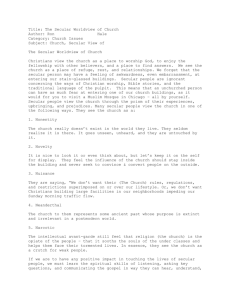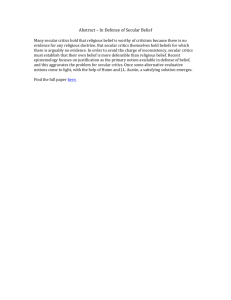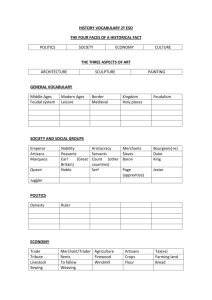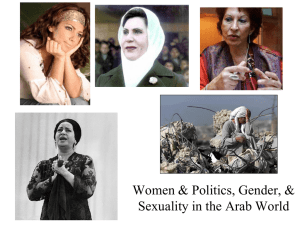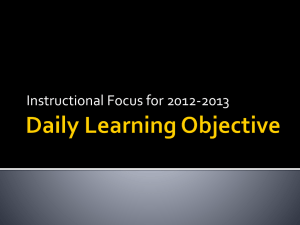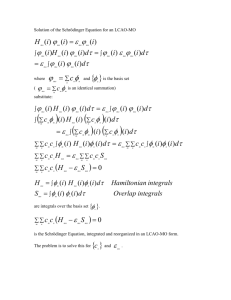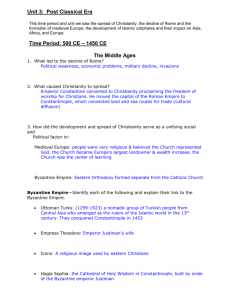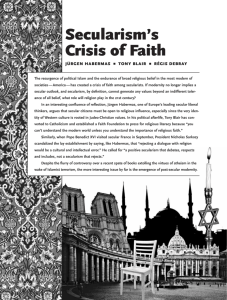Rigorous Curriculum Design
advertisement
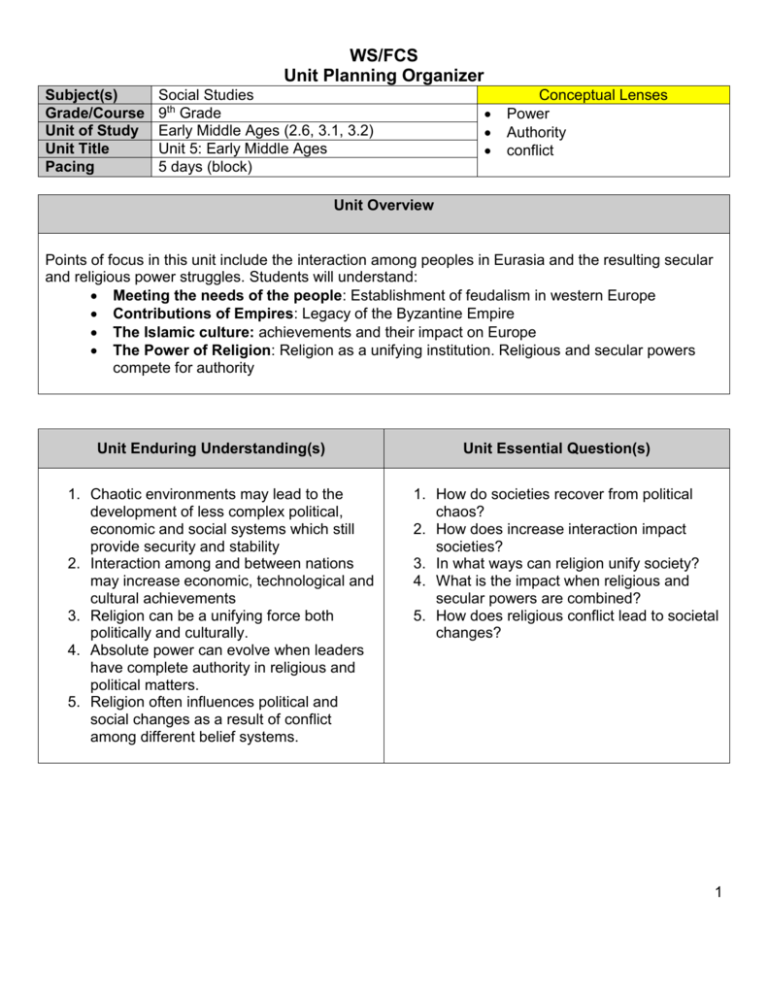
WS/FCS Unit Planning Organizer Subject(s) Grade/Course Unit of Study Unit Title Pacing Social Studies 9th Grade Early Middle Ages (2.6, 3.1, 3.2) Unit 5: Early Middle Ages 5 days (block) Conceptual Lenses Power Authority conflict Unit Overview Points of focus in this unit include the interaction among peoples in Eurasia and the resulting secular and religious power struggles. Students will understand: Meeting the needs of the people: Establishment of feudalism in western Europe Contributions of Empires: Legacy of the Byzantine Empire The Islamic culture: achievements and their impact on Europe The Power of Religion: Religion as a unifying institution. Religious and secular powers compete for authority Unit Enduring Understanding(s) 1. Chaotic environments may lead to the development of less complex political, economic and social systems which still provide security and stability 2. Interaction among and between nations may increase economic, technological and cultural achievements 3. Religion can be a unifying force both politically and culturally. 4. Absolute power can evolve when leaders have complete authority in religious and political matters. 5. Religion often influences political and social changes as a result of conflict among different belief systems. Unit Essential Question(s) 1. How do societies recover from political chaos? 2. How does increase interaction impact societies? 3. In what ways can religion unify society? 4. What is the impact when religious and secular powers are combined? 5. How does religious conflict lead to societal changes? 1 Essential State Standards Priority Objectives Supporting Objectives WH.H.2.6 Analyze the interaction between the Islamic world and Europe and Asia in terms of increased trade, enhanced technology innovation, and an impact on scientific thought and the arts. WH.H.3.1 Explain how religion influenced political power and cultural unity in various regions of the Europe, Asia and Africa. WH.H.3.2 Explain how religious and secular struggles for authority impacted the structure of government and society in Europe, Asia, and Africa. “Unpacked” Concepts (students need to know) WH.H.2.6 increased trade, enhanced technology innovation, and an impact on scientific thought and the arts WH.H.3.1 religion influenced political power and cultural unity in various regions of the Europe, Asia and Africa. “Unpacked” Skills (students need to be able to do) WH.H.2.6 Analyze (interaction) WH.H.2.6 Analyze WH.H.3.1 Explain (how) WH.H.3.1 Understand WH.H.3.2 Explain (how the impact) WH.H.3.2 Understand COGNITION (RBT Level) WH.H.3.2 religious and secular struggles for authority impacted the structure of government and society in Europe, Asia, and Africa. 2 Unit “Chunking” & Enduring Understandings Meeting the needs of the people When government is no longer able to meet the needs of the people, alternative systems often emerge to provide stability and security Contributions of Empires Empires are often measured by their lasting achievements and contributions to civilization. Essential Factual Content Suggested Lesson Essential Questions H G C & G E C Feudalism Manoralism Ruling elite How do societies respond when the government fails to meet their needs? X X X X What are the legacies (political, cultural, economic, and intellectual) of empires? How do societies impacted from regional interactions? X X X X X X X In the absence of a strong secular government, how does religious authority fill the political void? How does the struggle between religious and secular authority affect society? X X X X Military and economic Interaction between regions often leads to political, economic, and social innovations. The Islamic culture Religious cultural unity may develop into political authority Codifying laws Religious schisms Art & architecture Nation-states Cultural diffusion Taxation Social hierarchy Rebirth of learning Theocracy Secular Bureaucracy The Power of Religion The struggle for political power between secular and religious authorities often results in economic and social changes Sub Concepts Religion Secular X X X X 3 HISTORY GEOGRAPHY CIVICS & GOVERNMENT religion Power Authorities ECONOMICS CULTURE Society Religion Migration Innovation Civilization 4 Language Objective EXAMPLES Key Vocabulary LO: SWBAT define and explain the terms, feudalism, legacies, civilization and cultural diffusion Language Functions LO: SWBAT explain how societies respond when the government fails to meet their needs. Language Skills LO: SWBAT read a passage about the a empire and identify the effects of the empire’s achievements and contributions. (Reading passages should be chosen/modified in accordance with the LEP students’ zone of proximal development). Grammar and Language LO: SWBAT use adjectives and adverbs (to add details.) in an essay about a particular empire. . Lesson Tasks LO: SWBAT read and summarize a passage about the Islamic culture and explain this summary to a group. Language Learning Strategy LO: SWBAT develop a cause/effect graphic organizer analyzing and identifying the causes and effects of the declining of an empire. (The linguistic load will vary from LEP student to LEP student. Level 1-2 LEP students may need a word bank or other supplement to complete this activity using this strategy). Historical Thinking and Geography Skill Resources ○ “Straight Ahead” □“Uphill” ∆“Mountainous” Historical Thinking Geography Skills . 5 General Unit Resources SAS Curriculum Pathways #1224 Medieval Europe #1223 Early Islamic Civilizations #1338 Medieval Europe: The Crusades #381 Medieval Muslim Scholars Learn 360 Feudal Societies A Christian Nation Medieval Awakening Bridging World History Bridging World History Unit 12: Transmission of Traditions History for us All http://worldhistoryforusall.sdsu.edu/ Unit 5: Patterns of Interregional Unity 6

